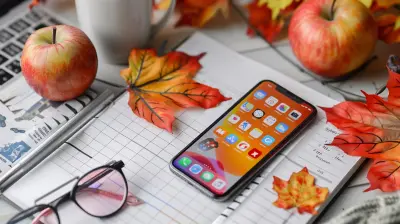Strategies for Teaching Students with Special Needs
23 November 2024
When it comes to teaching students with special needs, one size absolutely does not fit all. Every student is unique, and those with special needs often require a bit more creativity, patience, and adaptability from their teachers. You might feel overwhelmed or unsure about how to best support these students, but don’t worry—you’re not alone! With the right strategies, both you and your students can succeed.
In this article, we’ll explore practical, easy-to-implement strategies for teaching students with special needs. Whether you’re a seasoned teacher looking for new ideas, or you’re just getting started in education, these tips will help you create a classroom where every student can thrive.

Understanding Special Needs
Before diving into the strategies, it's important to understand what we mean by "special needs." This term covers a wide range of conditions, including learning disabilities (like dyslexia or ADHD), sensory impairments (such as deafness or blindness), and developmental disorders (like autism spectrum disorder or Down syndrome). Students with special needs often require different teaching approaches, tools, and sometimes additional support to grasp concepts and succeed academically.It’s important to remember that having special needs doesn’t mean a student is less capable—it just means they learn in a different way. The goal is to figure out how to tap into their strengths and work around their challenges.

1. Individualized Education Plans (IEPs) and 504 Plans
First things first, if you’re teaching students with special needs, you’ll likely run across an Individualized Education Plan (IEP) or a 504 Plan. These are legal documents that outline the support a student needs to succeed in school.- IEP: This plan is specifically for students who qualify under the Individuals with Disabilities Education Act (IDEA). It lists out the student’s learning goals and the specialized services they need, such as speech therapy or occupational therapy.
- 504 Plan: It’s less intensive than an IEP and is part of the Rehabilitation Act of 1973. This plan provides accommodations to ensure that the student has equal access to education, like extended time on tests or permission to use assistive technology.
You don’t need to be an expert in these plans, but it’s crucial to familiarize yourself with them because they provide insights into a student’s strengths, needs, and the strategies that work best for them.

2. Use Multisensory Teaching Methods
One of the best ways to engage students with special needs is through multisensory learning. This approach taps into multiple senses—visual, auditory, tactile, and kinesthetic—so that students can absorb information in a way that works best for them.- Visual learners might benefit from colorful charts, videos, or diagrams.
- Auditory learners may do better when they can listen to instructions or discussions.
- Tactile learners often need to physically interact with materials, like using manipulatives in math.
- Kinesthetic learners need to move around, perhaps acting out concepts or participating in hands-on activities.
For example, if you’re teaching a lesson on fractions, you could show a video (visual), discuss the steps (auditory), use fraction tiles (tactile), and have the students physically split objects into parts (kinesthetic). This method ensures that you’re covering all types of learners, and it keeps things interesting!

3. Break Tasks Into Smaller Steps
Students with special needs may find it hard to follow multi-step instructions or tackle large assignments all at once. To avoid overwhelming them, try breaking tasks down into smaller, manageable steps.For instance, if you're teaching students how to write an essay, instead of giving them the entire assignment at once, break it down. Start with brainstorming ideas, then move on to writing a thesis statement, next to drafting an introduction, and so on.
By chunking the tasks, you’ll make it easier for students to grasp the process and feel a sense of accomplishment at each step. Plus, breaking tasks down allows you to provide feedback along the way, ensuring they’re on the right track.
4. Incorporate Assistive Technology
Technology is a game-changer, especially in special education. Many students with disabilities struggle with tasks like writing, reading, or organizing their thoughts. Assistive technology can help bridge that gap.- Speech-to-text software: For students who struggle with writing, programs like Google Voice Typing or Dragon NaturallySpeaking allow them to dictate their ideas, which can take the pressure off and let them focus on content rather than mechanics.
- Text-to-speech programs: These tools, like NaturalReader or Kurzweil 3000, are excellent for students with dyslexia or other reading difficulties. They convert text into spoken words, making it easier to understand.
- Graphic organizers: Tools like MindMeister or Inspiration help students organize their thoughts visually, which is especially useful for those with ADHD or executive functioning challenges.
There’s a wide range of assistive technologies available nowadays, and many are even free or built into devices students already use (like smartphones or tablets). These tools can help students become more independent and boost their confidence.
5. Provide Clear and Consistent Instructions
Students with special needs often struggle with following complicated or vague instructions. That’s why it’s essential to be as clear and consistent as possible when giving directions.- Use simple, straightforward language.
- Break instructions down into short, manageable steps (like we discussed earlier).
- Accompany verbal instructions with written or visual cues. For example, you can write the steps on the board or use images to demonstrate what you mean.
It’s also helpful to repeat instructions and check for understanding. Ask the student to repeat back what they need to do or give them an example to ensure they’re on the same page.
6. Create a Structured and Predictable Environment
Many students with special needs, particularly those with autism or ADHD, thrive in an environment that’s structured and predictable. Routine is their best friend.- Use a daily schedule that’s visible to the whole class. Even better, use pictures or color codes to make it easier to understand.
- Give warnings before transitions. For instance, let students know when there are five minutes left before moving to the next activity. This can help them mentally prepare for the change.
- Set clear, consistent rules and consequences. When students know what to expect, they feel safer and are less likely to get anxious or act out.
Keep in mind that while structure is important, flexibility is key, too. Sometimes students will need a break from the routine, and that’s okay. Just be sure to communicate any changes ahead of time whenever possible.
7. Use Positive Reinforcement
Who doesn’t love a little praise and encouragement? Positive reinforcement can go a long way in helping students with special needs feel motivated and proud of their progress.- Focus on what the student does well, and acknowledge even small achievements.
- Use rewards that are meaningful to the individual student. Some may respond well to verbal praise, while others might prefer a sticker chart or extra free time.
- Be specific. Instead of saying “Good job,” say, “I love how you stayed focused during that activity.”
Positive reinforcement isn’t just about handing out rewards—it’s about building a student’s confidence and helping them realize they’re capable of success.
8. Foster Social and Emotional Skills
Academics are important, but so are social and emotional skills. Many students with special needs struggle in these areas, so it’s crucial to incorporate activities that help them develop these skills.- Model appropriate behavior: Show students how to interact with others by modeling good communication, empathy, and problem-solving.
- Social stories: These are short, simple stories that explain social situations and appropriate responses. They’re particularly helpful for students with autism who may struggle to understand social cues.
- Role-playing: Practice social interactions with your students through role-playing exercises. This gives them a safe space to develop their communication and problem-solving skills.
By nurturing social and emotional skills, you’re helping your students not just in the classroom, but in life.
9. Collaborate With Parents and Specialists
You’re not in this alone! Collaborating with parents and specialists (like speech therapists, occupational therapists, or special education teachers) is essential when teaching students with special needs.- Parents can provide insights into their child’s strengths, challenges, and what strategies work best at home. Keep the lines of communication open and work together to create consistency between school and home.
- Specialists can offer expert advice and additional resources. Don’t hesitate to reach out to the support team at your school for guidance or to ask for help implementing certain strategies.
By working as a team, you'll ensure that the student gets the best possible support both inside and outside the classroom.
10. Be Patient and Stay Positive
Finally, teaching students with special needs requires a lot of patience and a positive attitude. Progress may be slow at times, and you’ll likely face challenges along the way. But remember, every small step forward is a victory.Celebrate your students’ successes, keep a growth mindset, and remind yourself that you’re making a huge difference in their lives. You’ve got this!
Conclusion
Teaching students with special needs can be challenging, but it’s also incredibly rewarding. By using strategies like multisensory learning, breaking tasks into smaller steps, incorporating assistive technology, and fostering social and emotional skills, you can create a classroom environment where every student has the opportunity to succeed.Remember, every student is different, and what works for one might not work for another. Be flexible, stay patient, and don’t be afraid to try new things. With the right tools and mindset, you’ll be well-equipped to support your students on their educational journey.
all images in this post were generated using AI tools
Category:
Teacher ResourcesAuthor:

Olivia Chapman
Discussion
rate this article
17 comments
June McIntire
Effective strategies for teaching students with special needs include individualized instruction, collaborative learning, and fostering a supportive classroom environment.
February 1, 2025 at 1:06 PM

Olivia Chapman
Thank you for your insightful comment! Individualized instruction, collaboration, and a supportive environment are indeed key strategies for effectively teaching students with special needs.
Thalwen Chavez
Great insights! Effective strategies can truly empower students with special needs. Emphasizing individualized learning, collaboration, and patience fosters an inclusive environment that nurtures diverse learning styles. Keep up the good work!
January 29, 2025 at 12:17 PM

Olivia Chapman
Thank you for your encouraging words! I completely agree—individualized approaches and collaboration are key to fostering inclusivity and supporting diverse learners.
Anabella McMahan
Great insights! These strategies are essential for fostering an inclusive learning environment for all students.
January 25, 2025 at 12:02 PM

Olivia Chapman
Thank you! I'm glad you found the strategies helpful for promoting inclusivity.
Theodora Vasquez
Teaching students with special needs requires empathy and adaptability. By embracing diverse strategies and fostering an inclusive environment, educators not only empower these students but also enrich the learning experience for all.
January 22, 2025 at 11:30 AM

Olivia Chapman
Thank you for your thoughtful comment! I completely agree that empathy and adaptability are key in creating an inclusive environment that benefits all learners.
Uma McVaney
This article offers valuable insights into effective strategies for teaching students with special needs. Emphasizing individualized approaches, collaboration, and adaptive resources can significantly enhance learning outcomes. Implementing these techniques fosters an inclusive environment where all students can thrive. Great read!
January 16, 2025 at 1:53 PM

Olivia Chapman
Thank you for your thoughtful comment! I'm glad you found the strategies discussed helpful for fostering an inclusive learning environment.
Levi Barlow
Empowering strategies foster inclusive learning, ensuring every student reaches their full potential.
January 10, 2025 at 6:04 AM

Olivia Chapman
Thank you! Empowering strategies are indeed crucial for creating inclusive environments where all students can thrive.
Solenne Clark
Thank you for sharing these valuable strategies for teaching students with special needs. Your insights highlight the importance of inclusivity and adaptability in education, fostering a supportive environment where all students can thrive. Great work!
January 5, 2025 at 5:41 AM

Olivia Chapman
Thank you for your kind words! I'm glad you found the strategies helpful in promoting inclusivity and support in education.
Jasmine Vaughn
Empowering educators to embrace inclusive strategies is non-negotiable. Every student, regardless of challenges, deserves a tailored approach that fosters growth and confidence. Let’s dismantle barriers, celebrate differences, and redefine success in the classroom for all learners.
December 31, 2024 at 12:57 PM

Olivia Chapman
Absolutely agree! Embracing inclusive strategies is vital for fostering an environment where every student can thrive. Together, we can create a more equitable and supportive learning experience for all.
Yvonne Hodge
Teaching students with special needs is a journey of creativity and compassion. By embracing diverse strategies, we not only enrich their learning experiences but also grow as educators ourselves!
December 26, 2024 at 2:02 PM

Olivia Chapman
Thank you for your insightful comment! Embracing creativity and compassion truly transforms our approach and enriches the learning experience for both students and educators.
Nicholas Kim
This article effectively highlights diverse strategies for teaching students with special needs, emphasizing individualized approaches that foster inclusion and enhance learning outcomes for all.
December 23, 2024 at 8:30 PM

Olivia Chapman
Thank you for your feedback! I'm glad to hear that you found the strategies for individualized approaches valuable in promoting inclusion and improving learning outcomes.
Ardent Forbes
This article effectively highlights essential strategies for teaching students with special needs. However, it could further benefit from incorporating specific examples and case studies that illustrate how these strategies can be practically implemented in diverse classroom settings for maximum impact.
December 21, 2024 at 9:22 PM

Olivia Chapman
Thank you for your insightful feedback! I agree that incorporating specific examples and case studies would enhance the article, and I will consider this for future revisions.
Tessa Alvarez
This article offers insightful strategies for effectively teaching students with special needs. Emphasizing adaptability and individualized approaches, it highlights the importance of fostering an inclusive environment for all learners to thrive. Excellent resource!
December 18, 2024 at 5:26 AM

Olivia Chapman
Thank you for your kind words! I'm glad you found the strategies helpful in promoting inclusivity for all learners.
Lark McTigue
Tailored approaches enhance learning and engagement.
December 1, 2024 at 8:43 PM

Olivia Chapman
Absolutely! Tailored approaches are essential for meeting individual needs, fostering engagement, and maximizing learning outcomes for students with special needs.
Darius Hardy
Thank you for sharing these insightful strategies! It's heartwarming to see such dedication towards supporting students with special needs. Your practical tips will undoubtedly empower educators to create more inclusive and nurturing learning environments for all students.
November 28, 2024 at 8:31 PM

Olivia Chapman
Thank you for your kind words! I'm glad you found the strategies helpful in promoting inclusivity for all students.
Kylie McConkey
Great insights! Thank you for sharing these valuable strategies.
November 28, 2024 at 4:39 AM

Olivia Chapman
Thank you for your kind words! I'm glad you found the strategies helpful.
Garrett Watson
Empowering all learners brings joy to education!
November 27, 2024 at 4:54 AM

Olivia Chapman
Absolutely! When we empower all learners, we create an inclusive environment where everyone can thrive, leading to a more joyful and effective educational experience.
Olive McClure
Great insights! Practical strategies are essential for supporting all learners.
November 26, 2024 at 1:13 PM

Olivia Chapman
Thank you! I'm glad you found the insights helpful. Supporting all learners is indeed crucial.
MORE POSTS

The Power of Visualization in Achieving Exam Success

Differentiating Instruction for Students with ADHD

Overcoming the Digital Divide in E-Learning

Boosting Retention Rates in E-Learning Programs

How to Use Study Apps to Stay Organized and Efficient

How to Foster Critical Thinking in Elementary Students

Cultural Awareness and Social-Emotional Learning

How Virtual Reality Is Transforming the Future of Education

The Role of Active Recall in Long-Term Learning

Building Communication Skills for Better Networking

Differentiation in Early Childhood Education: Starting Strong